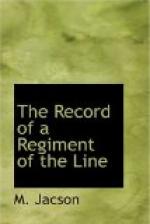General Kitchener’s brigade moved out from Lydenburg on to the race-course. The battalion being the leading regiment deployed and advanced towards a hill jutting out into the plain, with the mounted brigade of General Dundonald working round the left. This hill was afterwards known to the Regiment as Ben Tor. As the Regiment deployed into the open it came under shrapnel fire from two big guns posted on Paardeplaats. The Regiment was, however, extended, and had only one man wounded.
The Gordon Highlanders, who were in support, marched across the Boers’ front, in rear of the extended Devons, in column of companies. Several shells burst amongst them, and one shell, bursting thirty feet above graze, took their volunteer company end on and killed and wounded fifteen.
With Dundonald’s men on their left flank, four companies of the Regiment under Captain Jacson advanced up the spurs without opposition, whilst Major Davies, in command of the remaining companies, climbed the spurs on Jacson’s right. Little or no opposition was met with on this flank. Jacson’s companies were reinforced by four companies of the Gordon Highlanders and the 60th Rifles, and at 4 p.m., when nearing the summit, a thick mist came on, and the flanking brigade halted. Meanwhile Davies, with two of his companies, had reached the top of the hill and was proceeding down the far side when the fog lifted. It was then ascertained that the Boers, under cover of the fog, had left the position to which they had clung with great determination, and had retired. The position had been turned by Ian Hamilton’s right flank attack.
The thick mist saved the Boers, who would otherwise undoubtedly have lost their big guns in their retirement.
Just before dark the companies of the Regiment, which had become scattered, were collected, and Captain Jacson received an order to return with these to the old camp on the far side of Lydenburg; seven companies were thus taken down the hills over very rough country to the old camp, a distance of nearly six miles. On arrival there a message was received which stated that the army was encamped half-way up the hill towards Paardeplaats. The seven companies then returned, and finally reached camp very late. They had been marching and climbing incessantly from 7.30 a.m. till 10 p.m.
The brigades had by this time become rather intermingled. Of General Kitchener’s brigade the Manchester Regiment had been left behind at Witklip, at the north end of the Badfontein valley. A garrison had also been left at Lydenburg under General Howard, consisting of the Rifle Brigade and Leicesters, with General Brocklehurst’s Cavalry Brigade.
The Devonshire Regiment was now left behind at Paardeplaats, while General Buller’s force, consisting of the Gordon Highlanders and the 60th Rifles, with Dundonald’s Mounted Brigade, two Field Batteries, and the 5-inch guns, advanced on the 9th, the day following the capture of Paardeplaats, in the direction of the Mauchberg.




